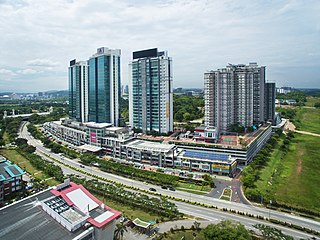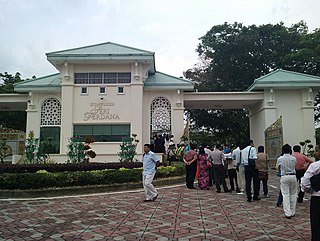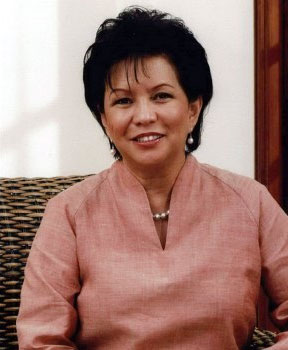
Putrajaya, officially the Federal Territory of Putrajaya, is the administrative centre of Malaysia. The seat of the federal government of Malaysia was moved in 1999 from Kuala Lumpur to Putrajaya because of overcrowding and congestion, whilst the seat of the judiciary of Malaysia was later moved to Putrajaya in 2003. Kuala Lumpur remains as Malaysia's national capital city per the constitution and is still the seat of the head of state and the national legislature, as well as being the country's commercial and financial centre.

Cyberjaya is a city with a science park as its core that forms a key part of the Kuala Lumpur in Malaysia. It is located in Sepang District, Selangor. Cyberjaya is adjacent to and developed along with Putrajaya, Malaysia's government seat. This city aspires to be known as the Silicon Valley of Malaysia.

Tunku Abdul Rahman Putra Al-Haj ibni Almarhum Sultan Abdul Hamid Halim Shah was a Malaysian statesman and lawyer who served as the first prime minister of Malaysia and the head of government of its predecessor states from 1955 to 1970. He was the first chief minister of the Federation of Malaya from 1955 to 1957. He supervised the independence process that culminated on 31 August 1957. As an independent Malaysia's first prime minister, he dominated the country's politics for the next 13 years.

The national flag of Malaysia, also known as the Stripes of Glory, is composed of a field of 14 alternating red and white stripes along the fly and a blue canton bearing a crescent and a 14-point star known as the Bintang Persekutuan. The 14 stripes, of equal width, represent the equal status in the federation of the 13 member states and the federal territories, while the 14 points of the star represent the unity among these entities. The crescent represents Islam, the country's state religion; the blue canton symbolises the unity of the Malaysian people; the yellow of the star and crescent is the royal colour of the Malay rulers, the red stripes represent bravery and the white stripes represent purity. It is in the stars and stripes family of flags.

The Sepang District is a district located in the southern part of the state of Selangor in Malaysia. Sepang District covers an area of around 600 square kilometers, and had an estimated population of 338,600 in 2023.

Independence Day, also known as National Day, is the independence day of the Federation of Malaya from the British Empire. It commemorates the Malayan Declaration of Independence of 31 August 1957, and is defined in article 160 of the Constitution of Malaysia. The day is marked by official and unofficial ceremonies and observances across the country.

The Sultan Abdul Samad Building is a late-19th century building located along Jalan Raja in front of Dataran Merdeka and the Royal Selangor Club in Kuala Lumpur, Malaysia. The building originally housed the offices of the British colonial administration, and was known simply as Government Offices in its early years. In 1974, it was renamed after Sultan Abdul Samad, the reigning sultan of Selangor at the time when construction began.

Independence Square is a square located in Kuala Lumpur, Malaysia. It is situated in front of the Sultan Abdul Samad Building. It was formerly known as the Selangor Club Padang, or simply the Padang, and was used as the cricket green of the Selangor Club. It was here that the Union Flag was lowered and the Malaysian flag hoisted for the first time at midnight on 31 August 1957. Since then, the Independence Square has been the usual venue for the annual Independence Day Parade.

The Perdana Putra is a building in Putrajaya, Malaysia which houses the office complex of the Prime Minister of Malaysia. Located on the main hill in Putrajaya, it has become synonymous with the executive branch of the Malaysian federal government.

The Putra Mosque is the principal mosque of Putrajaya, Malaysia. Construction of the mosque began in 1997 and was completed two years later.

Seri Perdana is the official residence of the prime minister of Malaysia, located in Putrajaya, Malaysia.

The Putrajaya International Convention Centre is a convention centre in Putrajaya, Malaysia. It occupies an area of 135,000 square meters in Precinct 5. The building began construction in 2001 and was completed in September 2003. It is designed by fourth prime minister Mahathir Mohamad to look like the eye of pending perak. It was renamed from the Putrajaya Convention Centre in October 2004 to its present name to reflect its international status on par with conference centres in world-class cities such as London, Tokyo and Paris.

Wisma Putra is a metonym for the Malaysian Ministry of Foreign Affairs. It is also the name of the RM170 million Ministry of Foreign Affairs complex located at the country's administrative capital, Putrajaya.

The Malaysian Houses of Parliament is a complex where the Malaysian Parliament assembles. The structure is located at the Perdana Botanical Gardens in Kuala Lumpur, close to the Malaysian National Monument.

Puchong is a major town and a parliamentary constituency in the Petaling District, in the state of Selangor, Malaysia. Bordering Kuala Lumpur, it is part of the Greater Kuala Lumpur area. It is bordered by Petaling Jaya in the north, Subang Jaya in the west, Cyberjaya and Putrajaya in the south, and Seri Kembangan in the east.
Persiaran Sultan Salahuddin Abdul Aziz Shah or Putrajaya Roundabout is the main thoroughfare or roundabout in Putrajaya, Malaysia. It is world's largest roundabout with a length of 3.5 km. It was named after Almarhum Sultan Salahuddin Abdul Aziz Shah of Selangor, the eleventh Yang di-Pertuan Agong. Major landmarks in Putrajaya including the Federal Government Complex, Perdana Putra, the Putrajaya Independence Square and Putra Mosque are located along this road.

Tun Jeanne Abdullah née Danker is married to the former Prime Minister of Malaysia, Tun Abdullah Ahmad Badawi. She married Abdullah Badawi while he was in office. She is his second wife after the death of Badawi's first wife, Endon Mahmood.
The Independence Day Parade is held every 31 August in commemoration of Malaya's independence. Since independence, the event has been usually held at the Independence Square in Kuala Lumpur, the original site of the first independence parade held on 1 September 1957.
Pulau Meranti is a village in Sepang District, Selangor, Malaysia.
Dato’ Seri Nik Mohamed bin Nik Mahmood is a Director of Kumpulan Senireka Sdn Bhd., a large commercial architecture firm in Kuala Lumpur, Malaysia. Mahmood founded the firm in 1973 after he left the Public Works Department. The firm specializes in commercial highrise buildings, and they have done some significant religious buildings. In the 1970s they were operating in the Brutalist idiom, but they turned to Postmodernism at the end of the century and were responsible for some prominent postmodern buildings in Malaysia, including the Menara Axis, 2002, Istana Negara Baru and the Kompleks Dewan Bahasa & Pustaka.






















